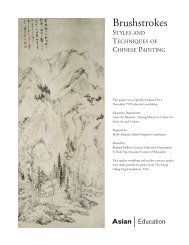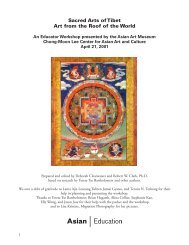Download PDF - Asian Art Museum | Education
Download PDF - Asian Art Museum | Education
Download PDF - Asian Art Museum | Education
You also want an ePaper? Increase the reach of your titles
YUMPU automatically turns print PDFs into web optimized ePapers that Google loves.
What does the dragon symbolize?<br />
Although the dragon is a fearful creature in Western mythology, in China and Japan the<br />
dragon represents the most powerful of all supernatural animals. It is the ruler of rain and<br />
wind and the producer of water sources, thus very appropriate decoration on a tea bowl, for<br />
pure, fresh water was essential to the tea ceremony. The dragon is believed to bring blessings<br />
of wealth, harmony, virtue, and long life. Ninsei’s ingenious design of a dragon coiled<br />
within a circle may remind students of the enso painting (slide # 19). It is possible that Ninsei<br />
intentionally alludes to this Zen form in his bowl.<br />
Activity/Discussion<br />
1) The Year of the Dragon in the Chinese Zodiac.<br />
From February 5, 2000 to January 23, 2001 is the year of the dragon in the Chinese<br />
zodiac, which is followed in Japan as well. Have students research their Chinese zodiac<br />
sign and the characteristics associated with it. Have them compare the features of the<br />
Chinese zodiac with their Western sign (e.g. Leo, Pisces). Are there conflicting features<br />
or similar ones? Which characteristics do they think accurately describe themselves and<br />
which don’t.<br />
2) Make a tea bowl.<br />
Using self-drying clay, students can hand-build a tea bowl. See Macdonald, p. 60–61 for<br />
detailed instructions.<br />
U-gene Kim contributed to this entry.<br />
<strong>Asian</strong> <strong>Art</strong> <strong>Museum</strong> <strong>Education</strong> Department
















